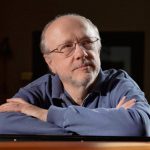October 23 & 25, 2025
Boston Symphony Hall
Boston, Massachusetts – USA
Boston Symphony Orchestra; Domingo Hindoyan, conductor; Yuja Wang, piano.
Leonard BERNSTEIN: Three Dance Episodes from On The Town
Sergei PROKOFIEV: Piano Concerto № 2 in g minor, Opus 16
Aaron COPLAND: Third Symphony
Karl Henning | 28 OCT 2025
Pianist, conductor, composer, educator & humanitarian Leonard Bernstein wrote rather a raftload of works for the stage, whereof easily the most celebrated is West Side Story, of which in recent memory Steven Spielberg made a new film version, a worthy successor to Robert Wise’s classic 1960 production.
But back in the autumn of 1944, Bernstein met a young dancer with the Ballet Theatre named Jerome Robbins (with whom, yes, Bernstein would also later collaborate on West Side Story). For his debut as a choreographer, Robbins sold his company on Fancy Free, depicting three sailors on shore leave in New York City.
Seeking a composer conversant in jazz and blues tropes, Robbins found Bernstein, arranging a commission from the Ballet Theatre for a scant $300. Robbins pressed Bernstein to keep the music, especially rhythms, as simple as possible; the composer protested that he was doing so, but he clearly wanted the rhythms to be interesting.
Premiered at the Metropolitan Opera in April 1944, Fancy Free was soon adapted and expanded by the writing team of Betty Comden and Adolph Green, as On the Town, which itself premiered just a few months after the parent ballet.
The three Dance Episodes extracted from On the Town for concert presentation are: 1. “The Great Lover Displays Himself” (wherein the first solo voice is the trombone—just reporting the musical fact), 2. “Lonely Town: Pas de Deux,” and 3. “Times Square: 1944.”
To the point of Bernstein discovering that the rhythms wanted to be interesting: this is music conceived for a relatively compact pit orchestra, with turn-on-a-dime rhythms and riddled with claustrophobic syncopation, which is not necessarily to suggest that the full Boston Symphony Orchestra has too wide a footprint for the piece, but only to emphasize the excellence of the orchestra in keeping the rhythms tight, agile and focused, as well as to applaud the collaboration with guest conductor Domingo Hindoyan.

Domingo Hindoyan conducts the BSO. (credit: Winslow Townson)
This is fearless music with no margin of error, and Saturday’s performance was breathtakingly good.
The brash young Sergei Prokofiev relished playing l’enfant terrible at the St Petersburg Conservatory and beyond. The Second Piano Concerto (dedicated to the memory of his friend Maximilian Schmidthof), cast in four movements, was the crowning compositional achievement of his Conservatory years.
Preparing for a September premiere at Pavlovsk (just outside Petersburg) Prokofiev wrote to his friend Nikolai Tcherepnin at the end of June, 1913, “I’m learning my new concerto, which has turned out to be disgracefully difficult and mercilessly tiring.”
It was also a piece sufficiently “Constructivist” (in the parlance of the time and place) to be a torment to conservative listeners. Wrote critic Vyacheslav Karatygin: “The public hissed. This is meaningless. In ten years’ time it will make amends for last night’s jeering by unanimously applauding a composer with a European reputation.”
Prokofiev left the score in Petrograd and it was subsequently lost in a fire during the upheavals of the Revolution; in 1923, while at Ettal in Bavaria, Prokofiev did not merely reconstruct the score of the Concerto from his sketches, but—notwithstanding the original version’s “disgraceful difficulty” and “merciless demands,” (as aforementioned)—pushed the envelope further still.
Most of the first movement was done by August’s end, leaving a gap for a cadenza which, he told Albert Coates, “only I am able to play.” Prokofiev’s wife, Lina, had been delivered of their son, Svyatoslav, in February, and we read of Lina’s horrified mother carrying the infant to that room in the apartment farthest from the piano while Prokofiev hammered away at his “devil of a cadenza,” composed afresh to even more gargantuan specifications.
Prokofiev would create the premiere of that version on May 8, 1924, in Paris, with Serge Koussevitzky conducting.
Soloist Yuja Wang was thoroughly admirable in following Prokofiev’s mercurial shifts in tone and character throughout Prokofiev’s wide-ranging musical landscape. Not only did she lean into the Concerto’s more athletic demands, but at times she played with a genuinely astonishing delicacy. Her choices were always sensitive and in key with the spirit of the piece.
At the conclusion of the Concerto, the response in the Hall was rapturously tumultuous.
The first encore she came back out for was one of Mendelssohn’s Lieder ohne Worte, whose light grace was in sharp dramatic contrast to the journey just concluded. She came out again to play the Toccatina from Nikolai Kapustin’s Eight Concert Etudes, a miniature whirlwind requiring such energy and intensity of rhythmic focus that one marvels at the artist with the mettle to present such an encore after the half-hour’s workout of the Prokofiev Op. 16.

Yuja Wang performs with the BSO. (credit: Winslow Townson)
Aaron Copland composed the first movement of his Third Symphony in 1944 (the year of Bernstein’s On the Town). The Symphony was a Koussevitzky Foundation commission for the BSO.
To the listener already acquainted with some of Copland’s œuvre, the most salient feature of the Symphony is the “arrival” in the fourth movement of the celebrated Fanfare for the Common Man, originally composed in 1942 for the Cincinnati Symphony Orchestra.
However, the rich ingenuity of the piece is how Copland took broken fragments of the Fanfare, and made them the motivic DNA for the entire piece, in spite (we might almost say) of the geographically scattered creative process: the four movements were completed in Tepoztlán, Mexico; Bernardsville, New Jersey; Ridgefield, Connecticut; and in New Hampshire and Massachusetts. Respectively.
The program, superbly executed, made significant demands upon guest conductor Domingo Hindoyan—an evening’s work to show us what he’s made of. Maestro Hindoyan was artistic, energetic, clear, had the visible respect of the orchestra, and was a model of poised self-possession.
We shall be seeing him again. ■
EXTERNAL LINKS:
- Boston Symphony Orchestra: bso.org
- Domingo Hindoyan: domingohindoyan.com
- Yuja Wang: yujawang.com

Read more by Karl Henning.
RECENT POSTS
 Marc-André Hamelin’s ‘Found Objects–Sound Objects’ offers an adventurous survey of contemporary piano music • 12 Dec 2025
Marc-André Hamelin’s ‘Found Objects–Sound Objects’ offers an adventurous survey of contemporary piano music • 12 Dec 2025 Ridibund Chamber Music Society offers mashups, mischief, and midwinter warmth at Eddie’s Attic • 09 Dec 2025
Ridibund Chamber Music Society offers mashups, mischief, and midwinter warmth at Eddie’s Attic • 09 Dec 2025




.png)